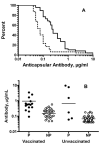Persistence of group C anticapsular antibodies two to three years after immunization with an investigational quadrivalent Neisseria meningitidis-diphtheria toxoid conjugate vaccine
- PMID: 15702041
- PMCID: PMC1413970
- DOI: 10.1097/01.inf.0000151035.64356.f8
Persistence of group C anticapsular antibodies two to three years after immunization with an investigational quadrivalent Neisseria meningitidis-diphtheria toxoid conjugate vaccine
Abstract
Background: An investigational quadrivalent (A, C, Y and W-135) meningococcal conjugate (MC-4) vaccine was reported to be more immunogenic in 2-year-olds than the currently licensed meningococcal polysaccharide vaccine, but persistence of serum antibody beyond 6 months after conjugate vaccination is unknown.
Objective: Determine persistence and the immunologic basis of protective activity of group C anticapsular antibodies in sera obtained 2-3 years after MC-4 vaccination.
Design: Group C antibody concentrations, bactericidal activity and passive protective activity were measured in sera from 48 children, ages 4-5 years, who had been immunized 2-3 years earlier with an MC-4 vaccine and from 47 children who had not been previously vaccinated.
Results: Serum antibody concentrations were higher in the vaccinated than the unvaccinated children (geometric means, 0.30 and 0.09 mug/mL, respectively, P < 0.0001). Bactericidal titers > or =1/4 (considered protective) were infrequent in both vaccinated and unvaccinated children (14.6 and 6.4%, respectively, P = 0.3). Passive protective activity against bacteremia in the infant rat model was more frequent in sera from vaccinated (37.5%) than sera from unvaccinated children (12.5%, P < 0.02). The proportion of sera with passive protective activity increased with increasing anticapsular antibody concentrations (P < 0.0001).
Interpretation: Serum group C antibody concentrations remained elevated for 2-3 years after MC-4 vaccination, and passive protective activity was more frequent in vaccinated than unvaccinated children. However, serum antibody concentrations in many vaccinated children were no longer sufficient to activate complement-mediated bacteriolysis in vitro or to confer passive protection against experimental group C disease.
Figures

Similar articles
-
Protective activity of group C anticapsular antibodies elicited in two-year-olds by an investigational quadrivalent Neisseria meningitidis-diphtheria toxoid conjugate vaccine.Pediatr Infect Dis J. 2004 Jun;23(6):490-7. doi: 10.1097/01.inf.0000129686.12470.e6. Pediatr Infect Dis J. 2004. PMID: 15194828 Clinical Trial.
-
Immunogenicity of an investigational quadrivalent Neisseria meningitidis-diphtheria toxoid conjugate vaccine in 2-year old children.Vaccine. 2005 Jul 29;23(34):4307-14. doi: 10.1016/j.vaccine.2005.03.031. Vaccine. 2005. PMID: 15921829 Clinical Trial.
-
Disparity in functional activity between serum anticapsular antibodies induced in adults by immunization with an investigational group A and C Neisseria meningitidis-diphtheria toxoid conjugate vaccine and by a polysaccharide vaccine.Infect Immun. 2003 Jun;71(6):3402-8. doi: 10.1128/IAI.71.6.3402-3408.2003. Infect Immun. 2003. PMID: 12761124 Free PMC article.
-
Quadrivalent meningococcal ACYW-135 glycoconjugate vaccine for broader protection from infancy.Expert Rev Vaccines. 2009 May;8(5):529-42. doi: 10.1586/erv.09.18. Expert Rev Vaccines. 2009. PMID: 19397410 Review.
-
Immunogenicity and safety of a meningococcal serogroup A, C, Y and W glycoconjugate vaccine, ACWY-TT.Adv Ther. 2013 May;30(5):431-58. doi: 10.1007/s12325-013-0032-5. Epub 2013 May 28. Adv Ther. 2013. PMID: 23712402 Review.
Cited by
-
Meningococcal Vaccination in the United States: Past, Present, And Future.Paediatr Drugs. 2025 May;27(3):331-349. doi: 10.1007/s40272-024-00666-2. Epub 2025 Feb 20. Paediatr Drugs. 2025. PMID: 39979767 Review.
-
Antibody persistence up to 5 years after vaccination of toddlers and children between 12 months and 10 years of age with a quadrivalent meningococcal ACWY-tetanus toxoid conjugate vaccine.Hum Vaccin Immunother. 2016;12(1):132-9. doi: 10.1080/21645515.2015.1058457. Hum Vaccin Immunother. 2016. PMID: 26575983 Free PMC article. Clinical Trial.
-
Protein carriers of conjugate vaccines: characteristics, development, and clinical trials.Hum Vaccin Immunother. 2013 Dec;9(12):2505-23. doi: 10.4161/hv.26109. Epub 2013 Aug 16. Hum Vaccin Immunother. 2013. PMID: 23955057 Free PMC article. Review.
-
Ex vivo model of meningococcal bacteremia using human blood for measuring vaccine-induced serum passive protective activity.Clin Vaccine Immunol. 2009 Jun;16(6):785-91. doi: 10.1128/CVI.00007-09. Epub 2009 Apr 1. Clin Vaccine Immunol. 2009. PMID: 19339487 Free PMC article.
-
Binding of complement factor H (fH) to Neisseria meningitidis is specific for human fH and inhibits complement activation by rat and rabbit sera.Infect Immun. 2009 Feb;77(2):764-9. doi: 10.1128/IAI.01191-08. Epub 2008 Dec 1. Infect Immun. 2009. PMID: 19047406 Free PMC article.
References
-
- Campbell JD, Edelman R, King JC, Jr, Papa T, Ryall R, Rennels MB. Safety, reactogenicity, and immunogenicity of a tetravalent meningococcal polysaccharide-diphtheria toxoid conjugate vaccine given to healthy adults. J Infect Dis. 2002;186:1848–1851. - PubMed
-
- Rennels M, King J, Jr, Ryall R, et al. Dose escalation, safety, and immunogenicity study of a tetravalent meningococcal polysaccharide diphtheria conjugate vaccine in toddlers. Pediatr Infect Dis J. 2002;21:978–999. - PubMed
-
- Granoff DM, Harris SL. Protective activity of group C anticapsular antibodies elicited in two-year-olds by an investigational quadrivalent Neisseria meningitidis-diphtheria toxoid conjugate vaccine. Pediatr Infect Dis J. 2004;23:490–497. - PubMed
-
- Harrison LH, Pass MA, Mendelsohn AB, et al. Invasive meningococcal disease in adolescents and young adults. JAMA. 2001;286:694–699. - PubMed
Publication types
MeSH terms
Substances
Grants and funding
LinkOut - more resources
Full Text Sources
Other Literature Sources

